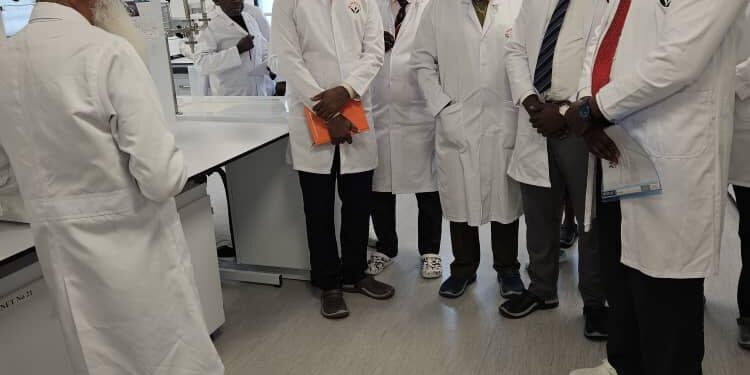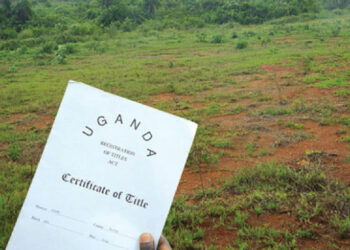MATUGGA – Members of Parliament’s Health Committee have on Tuesday, September 24 visited Dei BioPharma, a research-based biotechnology and pharmaceuticals firm, currently developing a drugs andvaccines manufacturing facility at Matugga, near Kampala.
The MPs toured the 150-acre facility at Matugga, guided by Chairman Dr. Patrick Wakida, and Board Pharmacist Dr. Arthur Kayanya.
The manufacturing plant project comprises 10 state-of-the-art facilities, specializing in vaccines, generics, nutraceuticals, oncology/cancer, penicillin, cephalosporins, non-beta-lactam, injectables, WFI, parentals, medical devices, and ophthalmic. The facility also boasts the YKTM GLP Biotech Laboratories, covering cancer research, QA/QC, drug discovery, gene therapy, cell therapy, mRNA therapeutics, vaccines, biosimilars, and biologics.
Five components, including the Generics section, warehousing facility, biotech laboratories, injectable facility, and vaccines plant, are ready for production.
Dei BioPharma was recognized as the best pharma company at the African Excellence Awards, organized by MEA Markets in London, UK.
The company’s development of biological drugs and vaccines manufacturing facility in Matugga will create upto 40,000 direct professional jobs.
Dr. Magoola, a Ugandan scientist and innovator has led Dei BioPharma to innovative discoveries, including the first US-patented chemical drug for treating malaria, the first mRNA universal vaccine against malaria, and mRNA vaccines against neurodegenerative disorders, diabetes, HIV/HPV.
Upon completion, the Matugga-based plant will introduce direly needed therapies, including anticancer drugs and novel vaccines targeting African infections. This will create role models for African scientists to lead research and development.
DEI BIOPHARMA MANUFACTURING PLANT *(Details and Progress Status)*
Under the facility that stands on a compus of 150 acres of land, Dei Biopharma Ltd will make the vital drugs for the region and beyond; including all types of vaccines on top of the mRNA vaccines, and other biological solutions listed as essential drugs including the Filgrastim, Erythropoietin, and Trastuzumab among several others.
Current Progress:
1. The Bio-tech Facility: The first biotech facility in Africa under US patent. These facilities will produce the latest cancer drugs, biosimilars, peptides, cell therapy, biologics, cytokines, therapeutic proteins, Gene therapy and vaccines including mNRA and others — subunit, recombiant, polysaccharide, and conjugate vaccines. The facility is fully compliant with FDA, EU-EMA and WHO standards.
*This is ready for production next year.*
2. State of the Art Injectables Facility ( *This also complete).*
3. The biggest Warehousing Facility in the region, complete with state-of the art cold chain technology capable of storing 60,000 pallets of mRNA and other vaccines, plus other pharmaceutical products *(This too is complete).*
4. The YKTM GLP Biotech Laboratories include the following components ;- Cancer research, QA/QC, drug discovery, gene therapy, cell therapy, mRNA therapeutics, vaccines, biosimilars and biologics. ( *This facility, too, is complete).*
5. The Generic Section: This will manufacture more than 150 products/different drugs and medicines. *(This facility is complete. It’s the one going to start manufacture of anti-biotics next month.)*
6. State-of-the-art Nutraceuticals Section: This facility will produce tablet, capsules, sachets, ointment, and syrup (under construction).
7. The Penicillin, Cephalosporin & Non-Beta Lactam Facility: (The design of these facilities has been completed as per the most stringent FDA, WHO and EU-EMA guidelines by consultants from the US and Europe, and their construction will be completed next year).
8. The Oncology/Cancer Manufacturing Facility has been designed to meet the most stringent FDA standards under EOL5 guidelines and technology (under construction).
9. The Virus Vaccines Facility: To be completed in the next year; will produce the following vaccines;-
(i) Tetanus Toxoid (TT) is a toxoid vaccine used to prevent tetanus.
(ii) Tetanus Diptheria vaccine, can prevent tetanus and diphtheria.
(iii) (Hep B) The Hepatitis B vaccine is also known as the first “anti-cancer” vaccine because it prevents hepatitis B, the leading cause of liver cancer worldwide.
(iv) (DTP-Hep B-Hib) Diphtheria, tetanus, whooping cough (pertussis) or DTP, polio, hepatitis B and Haemophilus influenzae type b (Hib) are 6 infectious diseases that are particularly dangerous to babies. Combined immunisations enable maximum protection to begin as soon as possible after birth.
(v) (TIV / QIV) The most commonly used influenza vaccines are injected inactivated influenza vaccines. These come in a trivalent (3 strains; TIV) and quadrivalent (4 strains; QIV) design.
(vi) (PCV 10) The PCV-10 vaccine protects against infection by the pneumococcus bacteria, one of the most common causes of pneumonia in children.
(vii) (TCV) Typhoid conjugate vaccines (TCVs) are of particular interest to the global health community because they have the potential to overcome many of the challenges that impeded uptake of earlier vaccines.
(viii) COVID-19 Vaccine.
(ix) (HPV Bivalent) Human Papillomavirus (HPV) Vaccination: Three HPV vaccines—9-valent HPV vaccine (Gardasil 9, 9vHPV), quadrivalent HPV vaccine (Gardasil, 4vHPV), and bivalent HPV vaccine (Cervarix, 2vHPV)—have been licensed by the U.S. Food and Drug Administration (FDA). All three HPV vaccines protect against HPV types 16 and 18 that cause most HPV cancers.
Do you have a story in your community or an opinion to share with us: Email us at editorial@watchdoguganda.com













